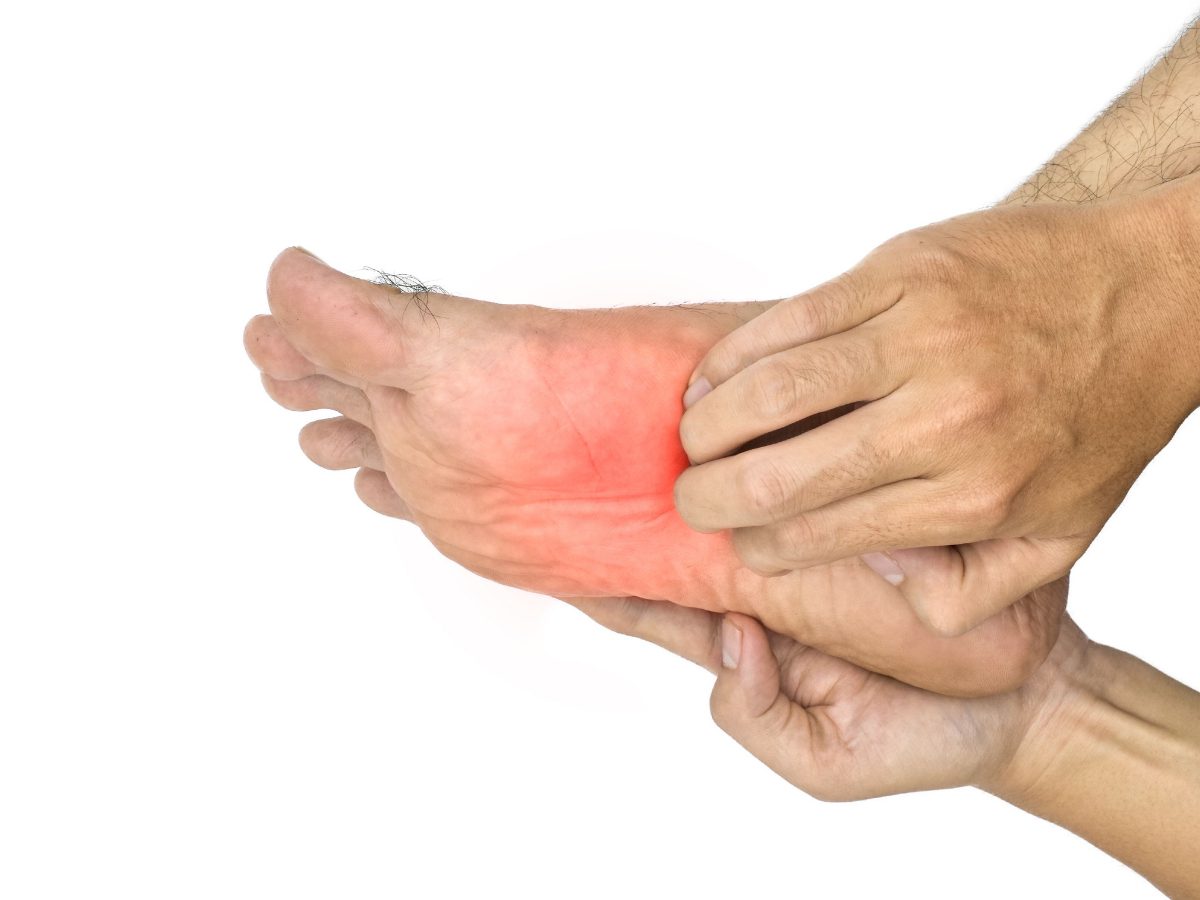
Foot fungus (tinea pedis, ringworm) is one of the most unpleasant problems that can control our feet and nails. Usually caused by the accumulation of just fungi in conditions that are good for them – moisture and low air access. Winter, when we put on heavy socks and winter footwear is a particularly fond time for it.
The infection can be harmless if we quickly locate and eradicate it, but if we trivialize the problem, the infection can even permanently damage the nails and skin of the feet. In this article you will learn exactly what nail and toenail fungus is, and how to fight it with home remedies.
What is tinea pedis?
Foot fungus is a fairly common condition that affects the skin of the feet and nails. It most often affects the interdigital spaces due to increased moisture and lack of ventilation, but if left untreated or ignored, it can move to the entire foot. It is caused – as you can easily guess – by fungi. More precisely, these are fungi of the dermatophyte genus, among which Trichophyton rubrum and Trichophyton mentagrophytes var. interdigitale predominate. In recent times, it can be said that ringworm has the hallmarks of a disease of civilization, and a significant part of the population undergoes it at least once.
Tinea pedis is not very dangerous or fatal, although untreated it can lead to localized skin damage. In most cases, a healthy body aided, for example, by increased hygiene during ringworm, can cope on its own and protect itself from spreading the infection. When the body is weakened, an additional antifungal agent – even a home remedy – may be necessary.
Types of tinea pedis
There are several types of athlete’s foot fungus, divided by where it occurs or the type of fungus itself that troubles us.
Interdigital ringworm – the most common type of ringworm, which occurs between the 4th and 5th toes. It is also known as athlete’s foot. As the disease progresses, the fungus spreads to the rest of the toes. This type is characterized by exfoliation and maceration (that is, destruction when the epidermis is too moist), and it is at this stage that it can cause cracks in the skin and the development of erosions, which in turn translate into pain. The disease is also accompanied by severe itching.
Exfoliative ringworm, or moccasin ringworm, appears on those parts of the skin that are covered by just this type of shoe – hence the second name. These include the heel, sole, side of the foot and the back of the foot near the toes. This infection causes dry erythematous and scaly erythema, which may even crack.
Another type is tinea pedis (dyshyrotic). The lesions appear mainly on the soles of the feet. It begins with the formation of seeding of small blisters, which burst and develop into erosions, or small cracks in the skin and wounds. It is mainly accompanied by pain and burning. If left untreated, it can develop into ulcerative ringworm, which a dermatologist specialist may be needed to treat.
Nail fungus is an infection where the fungal agent attacks the nails of the outer toes. This happens due to constant pressure from shoes (which you can avoid, for example, by using barefoot shoes). The affected nails are brittle, brittle with discoloration, and eventually there may be swelling and pain around the nail plate.
Virtually all of these types (except ulcerative) can be cured with home remedies as long as you react early enough and prevent the fungus from developing.
Tinea pedis – causes and symptoms
The most common causes of ringworm are related to skin hygiene. These can include:
- changes in pH,
- changes in the composition of epidermal lipids,
- excessive moisture,
- infrequent washing of feet,
- inappropriate shoes and socks,
- staying in public places without protection (e.g., swimming pool, sauna use)
- sharing footwear or bathroom accessories with others,,
But as you can see, practically most of it comes down to inadequate hygiene. As we mentioned, immunocompromised people are more susceptible to ringworm. If you notice alarming symptoms in yourself, such as redness, itching, unpleasant odor from shoes or socks, cracked and bad-looking skin, a fungal infection may have developed and it’s worth taking a harder look at hygiene and daily activities.
Prevention of tinea pedis
Prevention is very easy and is basically based on counteracting everything we mentioned in the paragraph above.
- do not wear someone else’s shoes,
- keep your feet hygienic and clean, and dry them after washing,
- wear socks made of natural materials (and change them often),
- take care of your footwear (changing insoles, disinfection),
- wear well-fitting footwear, with a wide toe box and made of airy, natural materials (leather, microfiber),
- take care to protect the foot in public places.
Just this much and so much will significantly reduce your exposure to fungal infections and allow you to enjoy healthy and nice feet.
Home remedies for ringworm
How to get rid of foot fungus? In most cases you can cope with home remedies, using things we have in our closets every day. If you develop foot fungus very quickly, we recommend going to a specialist, who can prescribe a special remedy for fungus like ointment or sprays.
Plants and herbs – garlic, aloe vera, rosemary, oregano
These and many other herbs are known for their antifungal and disinfectant properties. It is enough to rub the herb / plant firmly enough on the infected skin and wait a while, then wash the foot thoroughly and dry it. In some cases, it is recommended to make special poultices from aloe vera or garlic – just spread or apply a piece to the skin and wrap it in a bandage for some time (or even overnight). For example, garlic, the most popular in our homes, contains phytnocyds, substances with antibacterial effects. It also has an antifungal effect, of course, and nothing prevents you from rubbing a crushed clove into your skin.
Rosemary, on the other hand, contains several important oils (cineole, pinene, cymene) that inhibit fungal growth. You can use most herbs in the form of an infusion or use fresh pieces to rub in.
Baking powder and baking soda
These are basically two of the same ingredients, because in the case of baking powder we depend on the action of sodium bicarbonate, which is just baking soda. This agent is commonly used in household cleaning preparations, because it is safe for our body and very effective in removing fungi and bacteria. All you need to do is mix a tablespoon of baking soda with water and rub it on your skin, then rinse. You can also soak your feet for a while in a solution of water and baking soda (and add, for example, EPSOM salt, which we wrote about on the occasion of corns).
Tea tree oil
Tea tree oil is an ideal remedy for both skin and nail fungus. Full of fungicidal agents and easy to apply, and without the need for dilution. All that is needed is a few drops applied to the interdigital spaces, foot skin and nails and repetition for about 2 weeks. Tea oil should not be used by children and pregnant women.
Hydrogen peroxide with iodine
Otherwise known as hydrogen peroxide, hydrogen peroxide is an agent that, when applied to skin with an infection, carries out several chemical processes responsible for mechanical cleansing. Studies have shown that hydrogen peroxide with the addition of iodine can effectively eliminate most infections and is used readily both externally and internally. After applying to the skin, wait a few minutes, wash off and dry your feet well. You can repeat the process many times.
Talc
An interesting solution is to use talc, in other words, to create an unattractive means for the fungus to grow. Wash your feet thoroughly and wipe with a towel or dry with a hair dryer (remember, the towel must be fresh and intended only for this purpose). Then immediately sprinkle the fungal infection with talcum powder. It will absorb sweat during the day and prevent the skin fungus from developing.
Minimalist shoes to help prevent fungus on your feet!
One of the causes of ringworm that we have mentioned is inadequate footwear that puts pressure on our toes and does not allow the foot to breathe, increasing the risk of skin lesions. In this case, barefoot shoes are perfect. Why?
- our minimalist shoes are wide in the toes, so you won’t feel any pressure on your toes or nails. In addition to foot fungus, you can forget about other conditions like hallux, hammer toes and many others,
- we use only the best materials – vegan grain leather, natural cowhide and microfiber. All these materials allow the skin to breathe, which positively affects its health.
- we create our shoes, but also accessories like socks, using only natural and healthy materials,
- in addition, you benefit from a number of health-promoting features like a flexible zero-drop sole, which forces the natural choice of the foot.
Check out our wide range of women’s shoes, men’s shoes and children’s shoes. You’ll also find accessories such as toe separators that help , “air out” the space between the toes. With our shoes, no fungus is terrible!

Leave a Reply